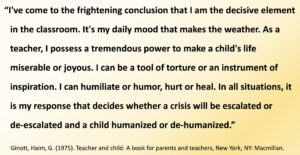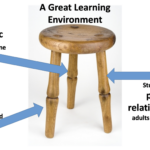Balancing Act: Starting the Year with Community Building and Testing-Prep
Original Article: https://www.responsiveclassroom.org/article/balancing-act
It’s the beginning of a new school year. You’re excited about your incoming class and have all kinds of plans for starting the year off right. Just one thing stands in the way: a few weeks in, standardized testing looms.
Testing throws off classroom schedules any time of year. But it can be especially disruptive during the first weeks of school, when teachers are still establishing ordinary classroom procedures. Fall testing can also hamper efforts to build a sense of classroom community. The relaxed, safe atmosphere that teachers seek to establish at the beginning of the year can be threatened by the anxiety that often dominates during test times.
Luckily, we don’t have to give up on establishing routines or building community in order to prepare students for test-taking success. In fact, you can achieve both goals by incorporating testing-prep into your beginning-of-the-year efforts to build a strong foundation for the year to come. Here are some strategies:
Speak with a Calm, Positive Tone about Testing
A teacher’s tone can dramatically influence the mood and atmosphere of the classroom, so it’s important to convey a sense of purpose and optimism about the upcoming tests.
If I roll my eyes, sigh, and say, “Okay, here’s some practice for these awful tests coming up,” I encourage negative attitudes about the tests. Or if I seem frantic, saying things like “You’ve got to do well! Our school is counting on you!” many students will likely develop stomachaches, headaches, and may even lose sleep.
Instead, try to project a positive, matter-of-fact attitude about testing. Explain that the tests are important, but not all-important: “These tests can give us a lot of information about what you already know and what we can work on next. You’re not supposed to get everything correct, but here’s a strategy that might help you do your best.”
Such language not only reduces anxiety about the tests, but also helps create a positive attitude toward school in general by sending the message that the adults at school are on the children’s side, supporting the children’s learning.
Keep Testing-Prep Sessions Quick and Light
I’ve found that several brief testing-prep sessions pay more dividends than lengthier practice. Try sprinkling five- to ten-minute practice sessions throughout the day, and focus on familiarizing students with test-taking skills. For example, if you’re going over how to fill in bubble-sheets, try a question such as:
- What’s something you like to do after school?
a. Play with a friend
b. Sports
c. Read
d. Play video games
e. Other
Sample items that don’t have wrong answers help children stay focused on the goal of the exercise—in this case, practicing how to fill in bubble-sheets. Plus, when students share answers to low-risk, personal questions such as the one above, they learn about each other and you learn about them, which helps build and strengthen community.
Start Each Day with Morning Meeting
Responsive Classroom Morning Meeting is a daily gathering that sets a positive tone and prepares students for the day ahead. During testing periods, Morning Meeting is an important anchor for students. Starting each day of the testing period with this predictable, safe routine allows your community-building work to continue, and you can adapt any of the components of Morning Meeting—greeting, sharing, group activity, and morning message—to help students prepare for testing. For example:
-
- Greeting: Do an around-the-circle greeting that gets students thinking about the tests. For example, students might greet the person next to them and name a way they’ll prepare for testing (getting a good night’s sleep, eating a healthy breakfast, playing a math game to practice facts, etc.).
-
- Sharing: Use the language of the test (“Summarize your weekend” or “What’s your favorite animal? Give three supporting details.”) when giving instructions for a “turn and talk” partner share. Choose a topic that will be easy for students to talk about, so they can concentrate on following directions and listening.
-
- Group activity: Use a fun song, chant, or game in the morning to help children relax and get some much-needed physical movement before a test. Activities learned during Morning Meeting can also be used later as energizers during breaks between test sessions.
- Morning message: Incorporate testing language and structures, such as true-false, multiple-choice, or fill-in-the-blank questions. Choose topics that help students get to know each other, such as favorite books or plans for the upcoming weekend. Besides being easy to answer and therefore allowing students to focus on practicing the format of the tests, such questions build a sense of community.
Model Procedures and Routines
One of the most important things we do with students at the beginning of the year is teach the routines that will make our school days run smoothly. Testing also goes more smoothly with the help of routines. You can use the Responsive Classroom practice called Interactive Modeling to teach the routines of testing, just as you would any classroom routine.
Interactive Modeling is a powerful technique for helping students learn and practice exactly how to complete a task. More often than not, children need clarification on procedures that may seem obvious to the teacher—procedures such as putting their test materials together at the end of a session.
Such modeling and practice can dramatically reduce the stress and tension that students feel when testing. Here are some other routines you could model and practice with students:
-
- Moving furniture to (and from) testing positions
-
- What to do when a pencil breaks
-
- What to do if you need to go to the bathroom
-
- What to do with water/snacks
-
- How to respond to an interruption (intercom, someone entering the room)
-
- What to do if you have a question
-
- How to pass out and collect materials
- What to do when you finish
Take Plenty of Movement Breaks
An extra recess or a whole-class game between testing sessions offers children a chance to blow off steam and have fun after sitting for long periods of time. Physical movement relieves stress and enables children to apply themselves to the next round of testing with renewed vigor. Plus, it can be a great way to continue to build a positive community, even in the middle of testing. Here are some ideas and considerations:
-
- Go outside! If the weather is nice, play quick games outside as often as you can. Let your students have an extra 20-minute recess (guilt-free!) at the end of the day.
-
- Have whole-class recess. Community-building tag games like “Toilet Tag” and “Excuse Me, Please” are great ways to get the blood pumping. Make sure to model and practice expected behaviors, such as safe tagging and following rules. Playing with your students will help keep the games fun and fair.
-
- A friendly game of kickball with the class down the hall can build class unity in a fun way, as long as teachers set a positive tone and are vigilant about enforcing kind and fair play.
-
- Use energizers! Sometimes you only have a few minutes for a movement break. A quick energizer gives students a physical and emotional respite from testing. (Looking for energizers? Check out Energizers! 88 Quick Movement Activities to Refresh and Refocus.)
-
- Teach simple songs with movements that student can do at their seats. Practice doing these quietly during Morning Meeting so you can do them even if the class next door is still testing. (Old favorites like “Heads, Shoulders, Knees, and Toes” and “Simon Says” can be engaging when done silently.)
- Be wary of competitive games. Often these are only fun for the few students who win. Any game that ends up with one or two winners and twenty-five or so losers should be avoided, especially during testing.
End the Day with a Closing Circle
After a long day of testing, students are often exhausted. Some may feel disheartened or defeated if they think they didn’t do well. So while ending the day on a positive note is always important, it’s especially important during testing periods.
One positive way to end the day is to gather for a closing circle. You might play a game or share reflections about how the day went. Try an around-the-circle sharing about what went well on the day’s tests, or about fun things students will do when they get home. This allows you to keep establishing the thoughtful, caring tone you want for your classroom while helping the children go home in a better mood. The goal is to create a relaxed ending to the day, so that students feel “we’re all in this together,” and notice that you as their teacher are in control and are looking out for them.
Testing is an inescapable part of the beginning of the year for many of us and for our students. With some adaptations, though, we can do testing-prep without sacrificing community building. We owe it to our students and ourselves to do both well.





